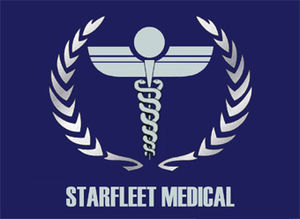Starfleet Combat Medicine Manual: Difference between revisions
Kane Morgan (talk | contribs) (Blanked the page) |
Kane Morgan (talk | contribs) mNo edit summary |
||
| Line 1: | Line 1: | ||
Historically in warfare, the majority of all combat deaths have occurred prior to a casualty ever receiving advanced trauma management. | |||
[[Image:SF Medical.jpg|left|thumb]]Aboard a ship, starbase, or planet-side colony, StarFleet '''Medical''' personnel provide day-to-day medical care, and treat injuries just like any other doctor. Their main responsibility is the physical well being and health of the crew and civilians on board their ship or base. They are also responsible for low-level sickness care. In crisis situations, this quickly changes and expands anywhere from low-level injury care to high-level surgery. | |||
The Chief Medical Officer (CMO) co-ordinates the efficient running of the Medical department and is responsible for the activities of the personnel therein. It is the CMO's job to ensure that the medical personnel are organized to ensure maximum productivity and also provide maximum medical and emergency response cover for the ship. | |||
---- | |||
THE 8 “CRITICAL” Combat Medicine TASKS: | |||
1) Contain Scene and Assess Casualties. | |||
Return Fire and Secure Scene. | |||
Direct Casualties to Cover. | |||
Evaluate for Life Threatening Injuries. | |||
Triage – Immediate, Delayed, Minimal, Expectant. | |||
Call Medical Personnel for Assistance as Required. | |||
2) Rapidly Identify and Control Massive Hemorrhage. | |||
Direct & Indirect Pressure. | |||
Tourniquet. | |||
Emergency Trauma Dressing. | |||
3) Inspect and Ensure Patent Airway. | |||
Open and Clear Airway. | |||
Nasopharyngeal Airway. | |||
4) Treat Life Threatening Torso Injuries. | |||
Occlusive Seal Dressing. | |||
Needle Decompression. | |||
Abdominal wound management. | |||
5) Inspect for Bleeding, Gain IV Access, Manage Shock. | |||
Head to Toe Blood Sweeps. | |||
18 Gauge Saline Lock. | |||
IV Fluids when dictated by Shock. | |||
Prevent Hypothermia. | |||
6) Control Pain and Prevent Infection. | |||
Combat Wound Pill Pack. | |||
7) Aid and Litter Team. | |||
Package and Prepare for Transfer. | |||
MEDCO, Litters, Manual Carries. | |||
8) Leader Coordinated Evacuation. | |||
Casualty Precedence – Critical (Urgent), Priority, Routine. | |||
MEDEVAC Coordination. | |||
Revision as of 13:31, 10 January 2012
Historically in warfare, the majority of all combat deaths have occurred prior to a casualty ever receiving advanced trauma management.
Aboard a ship, starbase, or planet-side colony, StarFleet Medical personnel provide day-to-day medical care, and treat injuries just like any other doctor. Their main responsibility is the physical well being and health of the crew and civilians on board their ship or base. They are also responsible for low-level sickness care. In crisis situations, this quickly changes and expands anywhere from low-level injury care to high-level surgery.
The Chief Medical Officer (CMO) co-ordinates the efficient running of the Medical department and is responsible for the activities of the personnel therein. It is the CMO's job to ensure that the medical personnel are organized to ensure maximum productivity and also provide maximum medical and emergency response cover for the ship.
THE 8 “CRITICAL” Combat Medicine TASKS:
1) Contain Scene and Assess Casualties.
Return Fire and Secure Scene. Direct Casualties to Cover. Evaluate for Life Threatening Injuries. Triage – Immediate, Delayed, Minimal, Expectant. Call Medical Personnel for Assistance as Required.
2) Rapidly Identify and Control Massive Hemorrhage.
Direct & Indirect Pressure. Tourniquet. Emergency Trauma Dressing.
3) Inspect and Ensure Patent Airway.
Open and Clear Airway. Nasopharyngeal Airway.
4) Treat Life Threatening Torso Injuries.
Occlusive Seal Dressing. Needle Decompression. Abdominal wound management.
5) Inspect for Bleeding, Gain IV Access, Manage Shock.
Head to Toe Blood Sweeps. 18 Gauge Saline Lock. IV Fluids when dictated by Shock. Prevent Hypothermia.
6) Control Pain and Prevent Infection.
Combat Wound Pill Pack.
7) Aid and Litter Team.
Package and Prepare for Transfer. MEDCO, Litters, Manual Carries.
8) Leader Coordinated Evacuation.
Casualty Precedence – Critical (Urgent), Priority, Routine. MEDEVAC Coordination.
